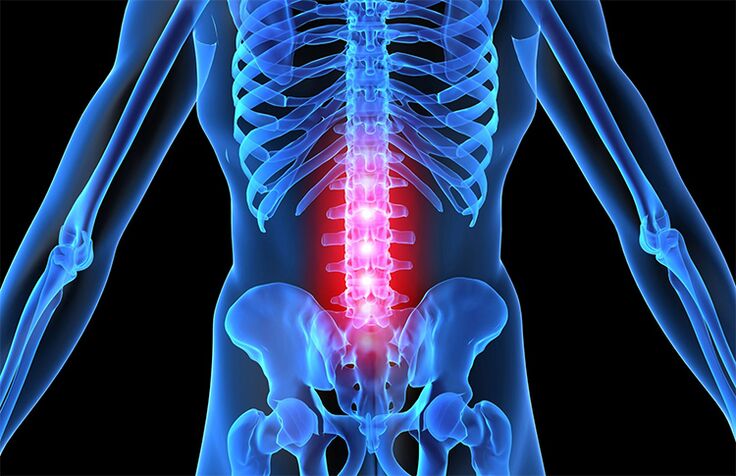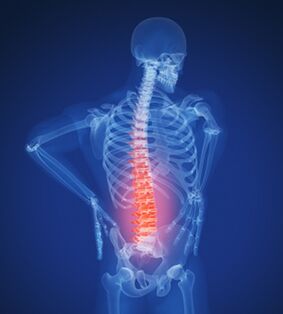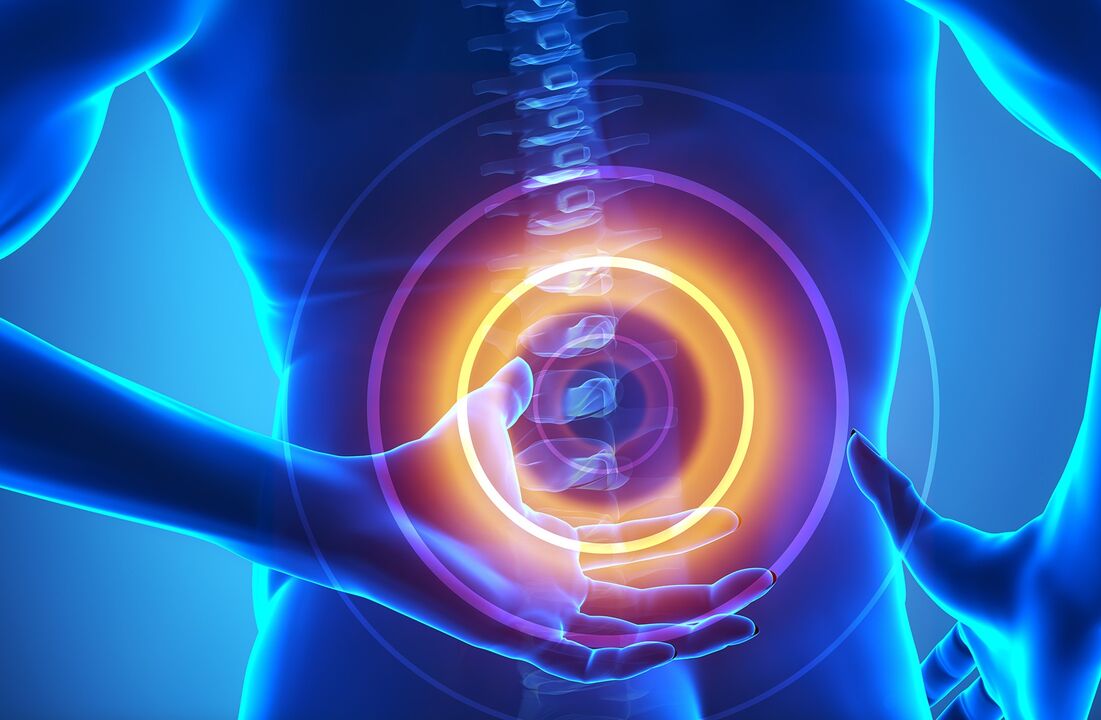
Many people have experienced lumbar pain at least once after thirty years. By the age of 60, this discomfort occurs in 80% of people. The cause is almost always lumbar osteochondrosis. This pathology provokes the development of unpleasant symptoms and can significantly impair the quality of human life. To prevent the development of negative consequences, it is extremely important to consult a doctor in time.
Clinical characteristics of osteochondrosis of the lumbar spine
This disease is widespread, as the lower back most often suffers from heavy loads. The lumbar region contains five vertebrae and also connects the sacrum with the thoracic region. The intervertebral discs, consisting of a pulpal nucleus, provide it with flexibility. These elements are located in the fibrous ring.
Osteochondrosis provokes a deficiency of nutrients in the discs. As a result, they become less elastic. In addition, their height is reduced. Reducing the distance between the vertebrae provokes a violation of the nerve roots. As a result, there is noticeable pain in the lumbar region.
In the initial stage, the symptoms of osteochondrosis are mild and may even be completely absent. However, further progression of the disease leads to back and leg pain and numbness may develop.
After the spread of the changes, the possibility of fixing the spine decreases. Hernias and subluxations sometimes occur - these disorders are associated with pain. Subsequently, even a rupture of the disc and pinching of the nerve endings can occur.
With the subsequent development of the disease, the vessels, ligaments and spinal cord begin to participate in the process. Bone growths may develop. At the last stage, paralysis and paresis develop. Sometimes the functioning of the pelvic organs is impaired.
In young people, the disease progresses steadily. In old age, the pathology may not manifest itself in any way, despite the presence of changes. If the treatment of the disease is not started in time, very dangerous consequences can develop.
Degrees
The pathology is irreversible and its symptoms are determined directly by the degree:
- First degree. During this period, pathological processes occur in the pulpal nucleus. There is discomfort associated with irritation of the nerve endings. They can be acute or painful in nature. If spasms of the large arteries of the thigh occur, blood circulation is disrupted, which is fraught with the appearance of pathologies of the arteries of the legs.
- Second specialty. The destruction of the fibrous ring progresses. Due to the loss of stability, the vertebrae become too mobile. As a result, muscle tissue is overloaded. The patient has high fatigue of the muscles of the lower back, a feeling of discomfort.
- Third degree. The fibrous ring breaks, which releases the contents of the pulpal nucleus. This process provokes the formation of hernias. There are radicular syndromes. Initially, the patient feels high sensitivity in the affected area, burning sensation, tingling, numbness. Sometimes sensitivity can disappear completely. In severe cases, paralysis and muscle atrophy develop.
- Fourth degree. The work of the vertebrae, the structure of the joints and the ligaments are disturbed. Osteoarthritis of the joints develops. The pain may disappear, the supporting function of the spine is restored, but the amplitude in it is significantly reduced. The fourth degree is characterized by various symptoms of the disease.
The reasons

More than a third of patients with such osteochondrosis have problems with the liver or digestive organs. In the presence of such deviations there is tension and spasms of muscles and blood vessels, which provokes oxygen deficiency and the appearance of dystrophic abnormalities. These processes are exacerbated by metabolic disorders.
The appearance of this form of osteochondrosis is often the result of congestion in the pelvic organs. They can be associated with constipation, colitis, hemorrhoids. In women, such problems are the result of inflammation of the appendages, and in men - prostatitis.
Causes of osteochondrosis also include the following:
- Lack of physical activity.
- Diseases of the joints.
- Digestive problems.
- Back injury.
- Pathology of the heart and blood vessels.
- Diseases of the endocrine system.
- Spine problems.
- Inflammation.
- Flat steps.
- Increased physical activity.
- Metabolic disorder.
- Age changes.
There are also risk factors that significantly increase the likelihood of developing lumbar osteochondrosis:
- Overweight;
- heredity;
- irrational eating;
- posture disorder;
- long stay in an awkward position;
- chronic insomnia;
- frequent stress;
- hypothermia.
Symptoms and signs
The disease manifests itself in the form of a pain syndrome and may be of a different nature. Osteochondrosis is characterized by pulling, pain, cutting sensations. Discomfort can be felt not only in the legs but also in the coccyx or lower chest.
The photo shows a pain syndrome in osteochondrosis in the lumbar spine

In addition to pain, there are such disorders:
- muscle strain;
- problems in the reproductive system;
- menstrual disorders in women;
- constipation;
- change in posture;
- asymmetry of the buttocks;
- loss of sensitivity;
- fatigue;
- numbness and cold in the legs;
- loss of activity;
- insomnia;
- emotional instability.
Exacerbation of osteochondrosis is usually the result of careless movement or heavy exercise. Also, recurrence of the disease due to hypothermia often occurs. Acute pain can be felt not only in the lower back - it often affects the lower extremities. During exacerbations, a person tries to find a comfortable position to achieve the disappearance of pain.
Symptoms of lumbosacral osteochondrosis
This form of the disorder is also characterized by back pain. They can be felt in the lower back or in the legs near the sciatic nerve. The manifestations of the disease do not appear immediately, but approximately in the second stage of the disease.
In the beginning they are felt at careless movements or loadings. But over time, the pain is constant and painful. Sometimes there are exacerbations when the discomfort becomes more pronounced. In advanced cases, the pain occurs when sneezing, coughing, light exertion.
When pinching the nerve endings, radicular syndrome develops, which is characterized by such manifestations:
- back shots;
- loss of sensation in the limbs;
- tingling in the legs;
- weakening of tendon reflexes;
- sweating disorder;
- cold feet;
- muscle weakness.
As the disease progresses, the back loses its flexibility and any changes in body position or load lead to severe pain. As a result, mobility is limited, a person has difficulty bending, muscle spasms.
Effects
If you ignore the symptoms of osteochondrosis, sooner or later the disease will lead to negative consequences. As the distance between the vertebrae decreases, the vessels become compressed, leading to problems with the nutrition of the spinal cord.
As a result, there is pain, muscle weakness, loss of reflexes. Enuresis, fecal incontinence, paralysis of the lower extremities may develop.
Another dangerous complication is hernia. It also provokes severe pain and compression of the spinal cord. As a result, the legs may lose sensitivity, the reflexes disappear. Sometimes the work of the organs of the reproductive and urinary systems is disturbed. Digestive problems can also occur.
This form of osteochondrosis can provoke instability of the spine. Under the influence of gravity, the lower back seems to slip out of the sacrum. In women, this condition is fraught with problems with internal organs - ovaries, uterus, appendages. Men can develop impotence as a result of this disorder.
Lumbar osteochondrosis often provokes circulatory problems in the spinal cord. Another consequence is compression myelopathy. Problems with the spinal cord occur in connection with the narrowing of the spinal canal.
The most complicated condition, however, is the "horsetail" syndrome, which is considered to be the result of a nerve root disorder. In advanced situations it can provoke paralysis and paresis of the limbs.
Diagnostic methods
To diagnose osteochondrosis, the doctor examines the patient's medical history and conducts a visual examination. General urine and blood tests are also performed. With their help other serious diseases can be ruled out.
An important criterion is the assessment of the condition of the legs. It is important to determine the condition of the skin, blood vessels, muscle tone. Women are additionally referred for consultation with a gynecologist. Men should be examined by a urologist.
The following types of diagnostics are required:
- radiography;
- CT scan;
- Magnetic resonance.
How to treat
Medical, physiotherapeutic and surgical techniques can be used to treat the disease. The main goal is to eliminate the manifestations of the disease and prevent its development.
Of the drugs used anti-inflammatory and analgesic drugs. Remember to take B vitamins. Sedatives and anticonvulsants are used to treat psychogenic disorders. Novocaine blockade may be used during exacerbations.
The most effective of the non-drug therapies are healing exercises, acupuncture and massage. You can also do electrophoresis and phonophoresis. If conservative methods do not work, surgery is performed.
Osteochondrosis of the lumbar region is considered a very dangerous pathology that can lead to extremely negative health consequences. To prevent this, it is very important to consult a doctor if you experience any back discomfort.


















